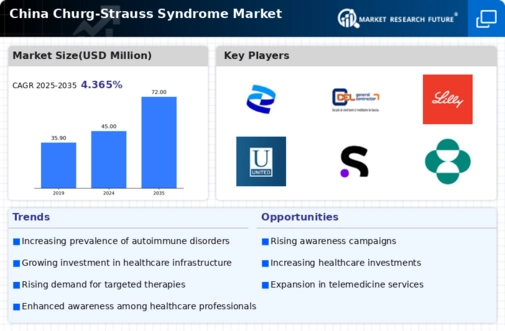Enhanced Regulatory Framework
The evolving regulatory framework in China is a critical driver for the churg strauss-syndrome market. The government has been actively reforming its regulatory processes to expedite the approval of new therapies, particularly for rare diseases. This includes streamlined pathways for clinical trials and faster review times for new drug applications. Such regulatory enhancements are likely to encourage pharmaceutical companies to invest in the development of treatments for Churg Strauss syndrome. As a result, the market may see a more rapid introduction of innovative therapies, which could significantly improve patient outcomes. Furthermore, the supportive regulatory environment may attract international companies to enter the market, increasing competition and potentially leading to more treatment options for patients. This dynamic is expected to positively influence the overall growth trajectory of the churg strauss-syndrome market.
Rising Healthcare Expenditure
The increase in healthcare expenditure in China is a pivotal factor influencing the churg strauss-syndrome market. As the country continues to develop economically, there is a corresponding rise in healthcare spending, which is projected to reach approximately 7.5% of GDP by 2025. This increase allows for greater investment in medical research, treatment options, and patient care services. Patients with Churg Strauss syndrome often require long-term management and specialized treatments, which can be costly. Therefore, higher healthcare expenditure may lead to improved access to necessary therapies and medications. Additionally, as insurance coverage expands, more patients are likely to seek treatment, further driving market growth. The overall enhancement of healthcare services is expected to create a more favorable environment for the market.
Investment in Healthcare Infrastructure
China's ongoing investment in healthcare infrastructure plays a crucial role in shaping the churg strauss-syndrome market. The government has been allocating substantial resources to improve healthcare facilities and access to specialized care. This investment is particularly relevant for rare diseases like Churg Strauss syndrome, where timely diagnosis and treatment are essential. Enhanced healthcare infrastructure facilitates better access to diagnostic tools and treatment options, which is vital for managing this complex condition. Furthermore, the establishment of specialized centers for rare diseases is likely to improve patient outcomes and increase the overall market size. As healthcare systems evolve, the churg strauss-syndrome market is expected to benefit from improved patient management and care pathways, ultimately leading to a more favorable environment for pharmaceutical companies.
Growing Research and Development Activities
The surge in research and development activities within China is a significant driver for the churg strauss-syndrome market. With a focus on rare diseases, numerous pharmaceutical companies are investing in innovative therapies and treatment modalities. The Chinese government has been encouraging R&D through various initiatives, including funding and grants for research projects targeting rare diseases. This environment fosters collaboration between academic institutions and industry players, leading to the discovery of novel therapeutic agents. As a result, the churg strauss-syndrome market is likely to witness an influx of new treatment options, which could enhance patient care and improve outcomes. The anticipated growth in R&D activities may also attract foreign investment, further bolstering the market landscape.
Increasing Incidence of Churg Strauss Syndrome
The rising incidence of Churg Strauss syndrome in China is a notable driver for the market. Recent studies indicate that the prevalence of this condition has been increasing, with estimates suggesting that it affects approximately 2 to 3 individuals per 100,000 people annually. This growing patient population necessitates enhanced diagnostic and therapeutic options, thereby stimulating market growth. As healthcare providers become more aware of the symptoms and complications associated with this syndrome, the demand for effective treatments is likely to rise. Consequently, pharmaceutical companies are motivated to invest in research and development, leading to a more robust pipeline of therapies. This trend is expected to significantly impact the churg strauss-syndrome market, as increased awareness translates into higher diagnosis rates and subsequent treatment needs.
























Leave a Comment